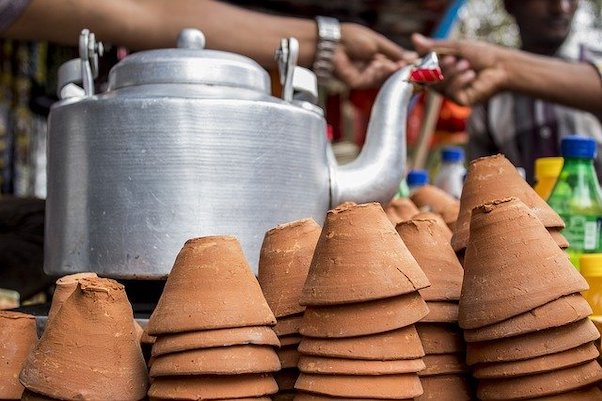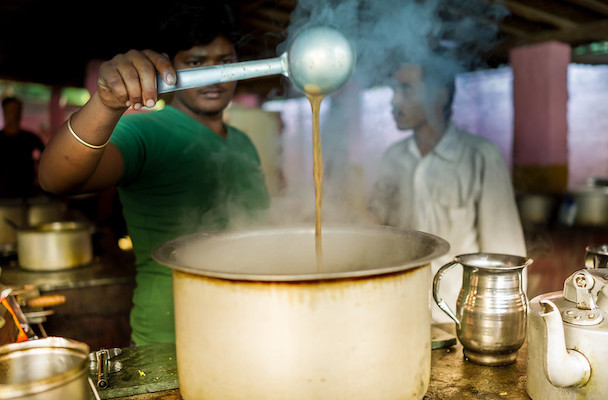INDIA
Why Not Try a Chai?
By Carina Cordero Brossy
Matthews, NC, United States
Imagine this scene: the streets are jammed with colorful food stalls, vendors calling out their tasty treats, and warm, fragrant smells of sizzling spices. Though it’s early morning in Kolkata, India, the air temperature is already sweltering. Among the meandering masses, one stall has attracted a gathering.
Taste and Toss
As I approach, I notice the vendor ladling out a silky, steaming brown liquid into small, raw clay cups. Customers buy their tea, sip the vessel dry, and then finish by tossing it unceremoniously to the ground where it shatters. Only after witnessing this process did I notice a growing collection of dusty shards of red clay alongside the tea stall and street.
The Chaiwala
Chaiwalas, or tea sellers, dot every street corner in every part of India. Their tea may be prepared and served from a fixed kiosk, a rolling food cart, or a makeshift tent. Sometimes a single person may even roam the streets carrying a giant, hot teakettle and a bucket of clay cups. No matter how they present their tea, chaiwalas are truly iconic of Indian culinary culture. Introduced during 19th-century British rule, tea is India’s most popular drink — the country consumes 837,000 tons of it every year! India is also the world’s second largest producer of tea, with 70 percent consumed within its borders.
Ingredients
This traditional Indian beverage blends black tea with steaming milk and warm South Asian spices such as:
- cinnamon
- anise
- ginger
- cardamom
- fennel
- black pepper
The particular blend of spices varies from region to region. Vendors typically create their own distinct blend to prepare for thirsty customers. Families might also make their unique recipe at home or at work and consume multiple cups (paper or clay) throughout the day.
TO MAKE ONE 8-OZ CUP OF CHAI
- 3/4 cup of water
- 1/4 cup of whole milk
- 2 teaspoons loose black tea leaves (ideally Assam or Ceylon)
- Some or all of the following spices: 2 green cardamom pods, 2 or 3 whole black peppercorns, 1/4 teaspoon fennel seeds, 1 or 2 sticks fresh cinnamon, 2 or 3 thin slices of fresh ginger
Heat water and milk together. Before mixture reaches a boil, add ginger and spices. Once boiling, add loose tea leaves. Turn off heat and steep for two minutes. Pour into a cup through a sieve to remove tea leaves and spices. Add sugar to taste. Enjoy!
Treasured Treat
As I watched the remains of discarded clay cups accumulate next to the chaiwala’s stall, I approached the rubble determined to find an intact cup to keep as a memento of this delectably creamy, spiced tea. After casually poking around the shards (so as not to draw attention to myself), I found three intact cups! I carefully placed each dry, brittle vessel into my backpack. Next came my journey home, traveling well over 7,000 miles with three airport layovers and endless hours of in-flight movies.
Ultimately Recyclable
Upon arriving at my destination, I was eager to check the status of my precious clay treasures. The first one I unwrapped was thoroughly crushed into dust. At that moment I realized the wisdom of customers tossing them to the ground. Because the clay is raw, the cups easily pulverize. With a good sweep and some rain, the remnants return back to the earth. The ultimate in recycling!
Can you spot the clay shards from smashed chai cups in this photo?

As I unpacked my second cup, I discovered it had split into three unfortunate fragments. Another loss. However, to my relief, the last one made the trip perfectly intact.
I mounted my small clay prize on a shelf in my house and paid homage to its incredible journey by making my own version of authentic Indian chai. You can try your own recipe, but for the best brew, you must visit the chaiwalas. Sip straight from the clay cup, and don’t forget to toss it on the ground when you’re done!
Have a suggestion for this story? We’d love for you to submit it!


Blank
Blank
Math Resources
Learning Activity for Grade 1: Addition and Subtraction
Sample Problems:
- If a chaiwala sells each two-ounce clay cup of chai for 10 rupees, how many ounces does he have to sell to make 150 rupees?
- When adding whole milk to a traditional chai recipe, you should use a 1:5 milk to water ratio. If a kettle contains 40 ounces of water, how much milk should one add? If adding a low-fat milk or non-dairy milk such as almond milk, your ratio should be closer to 1:1. Why is that?
Extension Questions
Over the years, cafes and restaurants all over North America have added chai and chai lattes to their permanent drink menus. Although still a popular purchase, many chai enthusiasts complain that companies like Starbucks sell a “fast food” version of chai. These beverages have very little in common with the true Indian taste.
- If the chai sold in countries like the US is so different from the chai consumed in India, should US companies be forbidden from marketing the drink using traditional Indian terms and images? Why or why not?
- Do your own taste test by comparing authentic chai with a mass-market version from a grocery store. Which do you prefer?
- Can you think of other food or drinks that have distinctly different tastes from their country of origin?
Explore Further
- Profiles of a few chaiwalas
- Chai Wallahs of India blog
- Another chai recipe
- Video of making chai in Delhi
Share Your Story
Write your own Global Math Story and send it to us!
Sorry, the comment form is closed at this time.